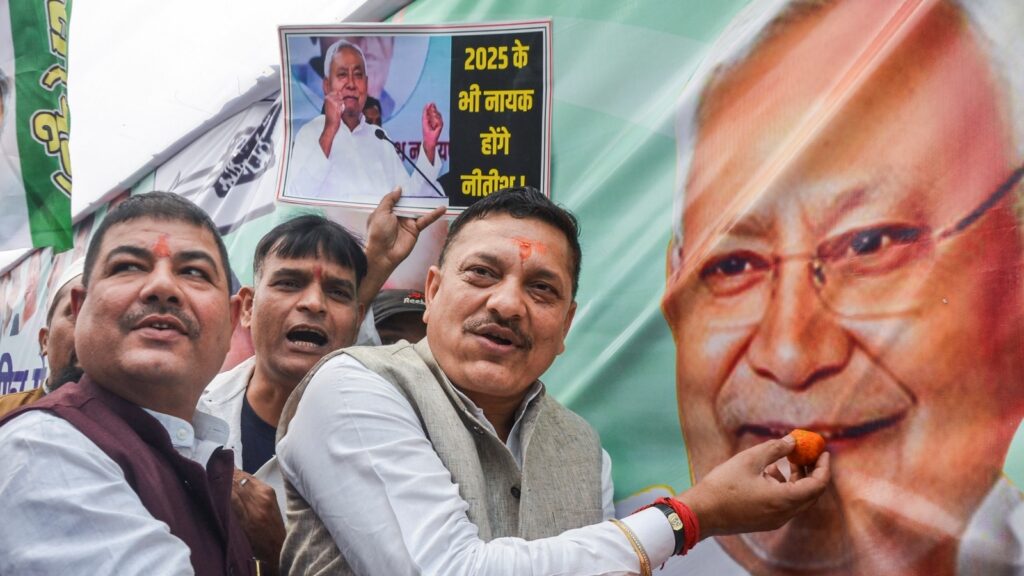As the NDA returns to power with an impressive 202 MLAs in Bihar’s 243-member Lower House, the newly elected 18th Assembly is older and richer than its predecessor. Not only are there more women this time, but the number of MLAs facing criminal cases has also dropped, shows an analysis of candidates’ election affidavits and data compiled by the Association of Democratic Reforms.
to power, their representation in the new Assembly has only risen by 3 MLAs, to 29 from 26 in the previous House, despite record-setting numbers of women turning out to vote.
The number of women MLAs in the Bihar Assembly has been declining since 2010, when 34 women were elected. In 2015, this dropped to 28 women MLAs, and again in 2020 to 26.
Out of 29 winning women candidates, 26 are from NDA and three are from the RJD.
The BJP that led the NDA to its landslide victory had fielded 13 women, of whom 10 won. The JD(U) had also fielded 13 women, with 10 of them emerging victorious. Notable among them is the BJP’s Maithili Thakur, a Bhojpuri devotional singer who won her first-ever election against RJD’s veteran leader Binod Mishra. Thakur is also the Assembly’s youngest MLA. In Chhapra, the BJP’s Chhoti Kumar also defeated the RJD’s Shatrughan Yadav, a popular Bhojpuri actor and singer.
Story continues below this ad
While NDA ally Chirag Paswan-led LJP(RV) saw three of its five women candidates win, the RLM’s only woman candidate – party chief Upendra Kushwaha’s wife Snehlata – won from Sasaram. Both the Jitan Ram Manjhi-led HAM(S)’s women candidates also won their seats.
In Opposition Mahagathbandhan, the RJD had fielded 24 women (the one of them had her nomination rejected), of whom three are now MLAs. The Congress had fielded five women, the CPI(M-L)L and Mukesh Sahani-led VIP each fielded one, but none were able to win.
The Prashant Kishor-led Jan Suraaj had fielded 25 women, while the Mayawati-led BSP had fielded 26. However, neither party saw any women win their seats
Despite women’s representation in the Assembly remaining consistently and considerably below that of men, women manage to outshine men in terms of voter participation. With overall turnout reaching a record-high of 67.13%, women’s turnout exceeded that of men for the fourth consecutive Assembly election, hitting 71.78% this year and exceeding men’s turnout of 62.98% by as much as 8.8 percentage points – the largest ever such gap.
Age
With as many as 111 MLAs winning re-election, the Assembly is now marginally older at an average age of 53 years, compared to 52 years in the previous House. Among the major parties, the LJP(RV) has the youngest MLAs at an average of 46 years, while the BJP and Congress’s MLAs are the oldest at 55 years.
The youngest newly elected MLA is 25-year-old Bhojpuri singer Maithili Thakur, who won from Alinagar on a BJP ticket. Just one other MLA, JD(U)’s 27-year-old Sonam Rani from Triveniganj, is under 30.
The oldest MLA is the JD(U)’s 79-year-old Bijendra Prasad Yadav, a former state Cabinet minister, who has won his ninth consecutive election from Supaul. As many as 72 MLAs are at least 60, while only 33 are under 40.
Assets
But the new MLAs are also collectively more than twice as rich now. The average assets of the previous Assembly’s members was Rs 4.32 crore, rising to Rs 9.02 crore now.
On average, among the parties that won more than one seat, the RLM, which has 4 MLAs, has the richest candidates at Rs 22.94 crore. The LJP(RV)’s 19 MLAs on average have assets worth Rs 13.67 crore, followed by the JD(U)’s 85 MLAs at Rs 9.54 crore, the BJP’s 89 MLAs at Rs 8.68 crore, the HAM(S)’s 5 MLAs at Rs 6.17 crore, the RJD’s 25 MLAs at Rs 5.81 crore, the Congress’s 6 MLAs at Rs 4.83 crore, the AIMIM’s 5 MLAs at Rs 2.17 crore, and the CPI(M-L)L’s 2 MLAs at Rs 1.47 crore.
The richest MLA is the BJP’s Munger representative Kumar Pranay, whose assets are worth Rs 170.82 crore. The MLA with the lowest assets also belongs to the BJP – Murari Pasavan from Pirpainti who has assets worth Rs 6.5 lakh.
Criminal cases
The number of MLAs facing pending criminal cases has dropped from 163 in 2020 to 130 this year. The MLAs account for 53% of the Assembly strength, the lowest on record since 2010. However, 102 MLAs, or 42% of the House, face serious cases, including murder and crimes against women, compared to 123 (or 51%) in the previous House.
At 54, the BJP has the most MLAs with pending cases, followed by the JD(U) at 31, the RJD at 18, the LJP(RV) at 11, and the Congress at 4, among the major parties.
The JD(U)’s strongman-turned-politician Anant Kumar Singh, who was elected from Mokama despite being in jail at the time of voting over the alleged murder of a Jan Suraaj supporter, has the most pending criminal cases at 28.

